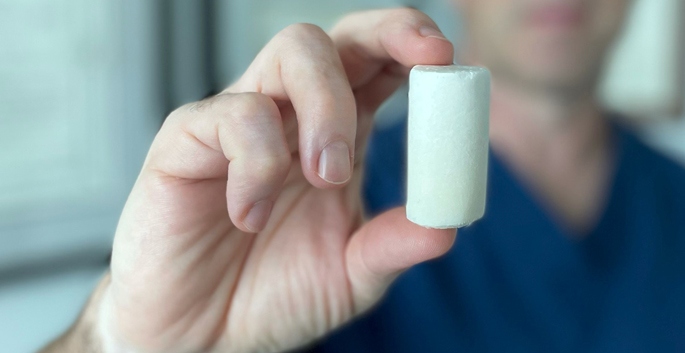
Charles Cox, MD, MPH, assistant professor of Orthopaedic Surgery, reconstructs between 100 and 125 anterior cruciate ligament (ACL) tears a year, replacing the old ligament with a new one made of surrounding tissues or tissue from a cadaver donor. This process is called an anterior cruciate ligament reconstruction.
For younger patients, previous multicenter NIH-funded research out of Vanderbilt University Medical Center has shown that use of the patellar tendon (BPTB) as a graft to replace the torn ligament works best to minimize the risk of future re-tear.
Currently considered the gold standard, BPTB replaced attempts to repair the torn ligament that failed because a blood clot could not form to kickstart the healing process.
Now torn ligament repair, instead of reconstruction, is getting a second look. In studies on children, a new, less invasive technique called Bridge-Enhanced ACL Restoration (BEAR) has been proven noninferior. VUMC is expanding that research with a randomized controlled study on adults ages 18-55 and is looking for additional candidates.
Participants will be randomized to either receive the BEAR implant or BPTB.
“With this study, we are revisiting the method of repairing the torn ligament,” Cox said. “In essence, we sew the torn stump of the ACL, connecting it back to the bone, and wrap it with a sponge-like implant containing growth factors that allow for healing. This allows the patient to retain the native ACL and avoid a formal reconstruction with less postoperative pain, possibly decreasing the risk of long-term post-traumatic osteoarthritis of the injured knee.”
Along with Cleveland Clinic, Brown University, The Ohio State University, University of Minnesota and the University of Colorado, VUMC was asked to be part of the study due to the high volume of ACL surgeries performed here.
“We knew going into the study that the data surrounding the outcomes of the bridge-enhanced ACL repair were comparable to traditional outcomes after ACL reconstruction in patients younger than 18 years old. However, it has been exciting to mirror those results in our own study patients who are no longer teenagers,” Cox said of the study, which began in 2020. “If we can ultimately show that outcomes are the same or improved with the bridge-enhanced ACL repair procedure in adults, then this will potentially change the standard treatment of ACL injuries throughout the country.”
This procedure is only available currently through the study, which is open to patients ages 18-55 with an ACL tear who can have surgery within 50 days of the injury. Interested patients can email study coordinator Rosemary Sanders at rosemary.a.sanders@vumc.org.
“We are excited about the prospects of ACL repair in appropriate situations and believe this is an important study to determine the patients that will benefit from the BEAR intervention,” said Rick Wright, MD, the Dan Spengler, MD Professor and chair of the Department of Orthopaedic Surgery.












